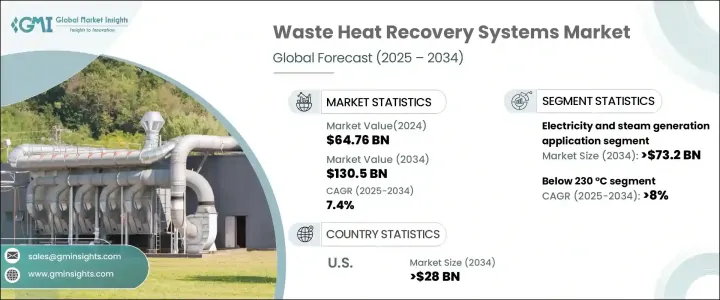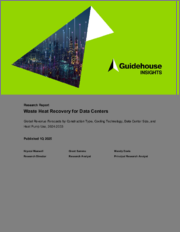
|
시장보고서
상품코드
1684843
폐열 회수 시스템 시장 기회, 성장 촉진요인, 산업 동향 분석, 예측(2025-2034년)Waste Heat Recovery Systems Market Opportunity, Growth Drivers, Industry Trend Analysis, and Forecast 2025 - 2034 |
||||||
세계의 폐열 회수 시스템 시장은 2024년에 647억 6,000만 달러에 이르렀으며, 지속가능성에 대한 노력 증가, 엄격한 환경 규제, 에너지 효율의 진보에 견인되어 2025년부터 2034년까지 연평균 복합 성장률(CAGR) 7.5%를 나타낼 것으로 예측되고 있습니다.
다양한 산업의 기업들이 자원 이용 최적화, 에너지 효율 향상, 진화하는 규제 요건에 대응하기 위해 폐열 회수 솔루션의 채용을 늘리고 있습니다. 이 시스템은 산업 공정에서 여분의 열을 회수하고 사용 가능한 에너지로 변환하여 이산화탄소 배출량을 줄이고 운영 비용을 줄입니다. 시멘트, 유리, 화학, 석유 정제 등의 산업이 비용 효율적인 솔루션을 요구하는 가운데, 폐열 회수 기술은 현대 산업 운영에 필수적이 되고 있습니다. 보다 깨끗한 에너지 솔루션과 지속가능성 향상을 목표로 하는 움직임은 이러한 첨단기술의 채용을 계속 강화하고 있어 세계의 에너지 전환의 중요한 요소가 되고 있습니다.

세계 산업계가 탄소 발자국을 줄이고 장기적인 에너지 효율을 달성하는 데 주력하는 가운데, 폐열 회수 시스템은 기세를 늘리고 있습니다. 기업들은 이러한 기술이 환경 보전에 기여할 뿐만 아니라 에너지 소비를 줄임으로써 상당한 비용 절감을 실현한다는 것을 인식하고 있습니다. 순환형 경제에 대한 노력이 중시되고, 에너지 효율적인 제조 공정이 추진되고 있는 것이 시장 확대를 가속화하고 있습니다. 게다가 열교환기, 열전 발전기, 유기 랭킨 사이클의 기술 진보가 시스템 효율을 높여 폭넓은 산업에 매력적이 되고 있습니다. 정부의 인센티브와 청정 에너지를 촉진하는 유리한 정책은 폐열 회수 솔루션의 채택을 더욱 강화하고 있습니다. 기업이 지속가능성에 우선순위를 두고 있는 가운데 이러한 시스템에 대한 수요는 급증하고 산업용 에너지 관리의 미래를 재구축할 것으로 예상됩니다.
| 시장 범위 | |
|---|---|
| 시작 연도 | 2024년 |
| 예측 연도 | 2025-2034년 |
| 시작 금액 | 647억 6,000만 달러 |
| 예측 금액 | 1,305억 달러 |
| CAGR | 7.5% |
2034년까지 전기·증기 발전 부문은 732억 달러를 창출할 것으로 예상됩니다. 지구환경문제와 온실가스 배출량 증가에 대한 우려가 높아지면서 산업계는 에너지 효율적인 솔루션을 사업 운영에 통합할 필요가 있습니다. 폐열 회수 기술은 여열을 회수하여 발전에 재이용함으로써 이러한 우려에 효과적으로 대처하고 사업의 지속가능성을 대폭 개선합니다. 세계 산업계가 탈탄소화에 대한 노력을 강화하는 가운데, 폐열 회수 시스템은 에너지 효율을 높이고 배출량을 줄이는데 필수적인 도구가 되고 있습니다. 기업은 폐열 회수 도입으로 인한 비용 절감부터 법규 준수 개선에 이르기까지 장기적인 이점을 점점 더 인식하고 있으며 시장의 지속적인 성장을 추진하고 있습니다.
230°C 이하에서 작동하는 폐열 회수 시스템 시장은 2034년까지 연평균 복합 성장률(CAGR) 8%를 나타낼 것으로 예상됩니다. 펄프·제지, 식품 가공, 화학 등 온도 범위가 완만한 산업에서의 채용이 증가하고 있는 것이 확대에 박차를 가하고 있습니다. 산업 공정으로부터의 폐열은 에너지 회수의 큰 기회가 되기 때문에 이러한 분야는 회수 기술을 채용하는 주요 기업이 되고 있습니다. 이러한 시스템에 투자하는 기업들은 장기적인 비용 절감, 에너지 소비 감소, 탄소 배출량 최소화로부터 혜택을 누리며 지속가능성에 대한 노력을 강화하고 있습니다. 자원의 최적화와 에너지 효율이 우수한 제조업에 대한 주목 증가는 이러한 첨단 시스템에 대한 수요를 더욱 높여주고 있습니다.
미국의 폐열 회수 시스템 시장은 높은 에너지 비용, 까다로운 환경 규제, 지속 가능한 산업 관행으로의 변화 증가를 배경으로 2034년까지 280억 달러를 창출할 전망입니다. 다양한 분야의 기업들이 에너지 효율을 높이고 탈탄소화에 대한 노력을 지원하기 위해 최첨단 폐열 회수 솔루션에 많은 투자를 하고 있습니다. 회수열을 발전에 이용하고 종래의 에너지원에 대한 의존을 줄이는데 초점을 맞춘 이니셔티브로 산업계와 기술공급자와의 협력체제는 시장을 더욱 강화하고 있습니다. 산업계가 지속가능성과 비용효율을 우선시하는 가운데 폐열 회수 기술에 대한 수요는 가속되어 에너지관리와 산업운영의 미래를 형성하게 될 것으로 보입니다.
목차
제1장 조사 방법과 조사 범위
- 시장 범위와 정의
- 시장 추계·예측 파라미터
- 예측 계산
- 데이터 소스
- 1차 데이터
- 2차 데이터
- 유료
- 공적
제2장 주요 요약
제3장 업계 인사이트
- 생태계 분석
- 규제 상황
- 업계에 미치는 영향요인
- 성장 촉진요인
- 업계의 잠재적 위험 및 과제
- 성장 가능성 분석
- Porter's Five Forces 분석
- PESTEL 분석
제4장 경쟁 구도
- 서론
- 전략적 전망
- 혁신과 지속가능성의 전망
제5장 시장 규모와 예측 : 용도별(2021-2034년)
- 주요 동향
- 예열
- 전기 및 증기 발생
- 증기 랭킨 사이클
- 유기 랭킨 사이클
- 칼리나 사이클
- 기타
제6장 시장 규모와 예측 : 온도별(2021-2034년)
- 주요 동향
- 230°C 미만
- 230°C-650°C
- 650°C 초과
제7장 시장 규모와 예측 : 최종 용도별(2021-2034년)
- 주요 동향
- 석유 정제
- 시멘트
- 중금속 제조
- 화학
- 펄프 및 제지
- 식음료
- 유리
- 기타 제조업
제8장 시장 규모와 예측 : 지역별(2021-2034년)
- 주요 동향
- 북미
- 미국
- 캐나다
- 멕시코
- 유럽
- 영국
- 독일
- 프랑스
- 스페인
- 이탈리아
- 아시아태평양
- 중국
- 인도
- 일본
- 호주
- 한국
- 중동 및 아프리카
- 사우디아라비아
- 아랍에미리트(UAE)
- 남아프리카
- 라틴아메리카
- 브라질
- 아르헨티나
제9장 기업 프로파일
- Aura
- BIHL
- Bosch Industriekessel
- Climeon
- Cochran
- Durr Group
- Echogen
- Exergy International
- Forbes Marshall
- General Electric
- IHI Power Systems
- John Wood Group
- Mitsubishi Heavy Industries
- Ormat
- Promec Engineering
- Rentech Boilers
- Siemens Energy
- Sofinter
- Thermax
- Viessmann
The Global Waste Heat Recovery Systems Market reached USD 64.76 billion in 2024 and is projected to expand at a 7.5% CAGR from 2025 to 2034, driven by rising sustainability initiatives, stringent environmental regulations, and advancements in energy efficiency. Companies across multiple industries are increasingly adopting waste heat recovery solutions to optimize resource utilization, enhance energy efficiency, and meet evolving regulatory requirements. These systems capture excess heat from industrial processes and convert it into usable energy, reducing carbon emissions and lowering operational costs. With industries such as cement, glass, chemicals, and petroleum refining seeking cost-effective solutions, waste heat recovery technologies are becoming indispensable in modern industrial operations. The push toward cleaner energy solutions and improved sustainability practices continues to reinforce the adoption of these advanced technologies, making them a critical component of the global energy transition.

As industries worldwide focus on reducing carbon footprints and achieving long-term energy efficiency, waste heat recovery systems are gaining momentum. Companies are realizing that these technologies not only contribute to environmental conservation but also provide significant cost savings by reducing energy consumption. The growing emphasis on circular economy practices and the push for energy-efficient manufacturing processes are accelerating market expansion. Furthermore, technological advancements in heat exchangers, thermoelectric generators, and organic Rankine cycles are enhancing system efficiency, making them more attractive to a wide range of industries. Government incentives and favorable policies promoting clean energy further support the adoption of waste heat recovery solutions. As businesses continue prioritizing sustainability, demand for these systems is expected to surge, reshaping the future of industrial energy management.
| Market Scope | |
|---|---|
| Start Year | 2024 |
| Forecast Year | 2025-2034 |
| Start Value | $64.76 Billion |
| Forecast Value | $130.5 Billion |
| CAGR | 7.5% |
By 2034, the electricity and steam generation segment is projected to generate USD 73.2 billion. Rising concerns over global environmental issues and increasing greenhouse gas emissions are pushing industries to integrate energy-efficient solutions into their operations. Waste heat recovery technologies effectively address these concerns by capturing residual heat and repurposing it for power generation, significantly improving operational sustainability. With global industries intensifying their decarbonization efforts, these systems have become essential tools for enhancing energy efficiency and reducing emissions. Businesses are increasingly recognizing the long-term benefits of implementing waste heat recovery, from cost reductions to improved regulatory compliance, driving sustained market growth.
The market for waste heat recovery systems operating at temperatures below 230 °C is expected to grow at a CAGR of 8% through 2034. The expansion is fueled by rising adoption in industries with moderate temperature ranges, including pulp and paper, food processing, and chemicals. Waste heat from industrial processes presents a substantial opportunity for energy recovery, making these sectors key adopters of recovery technologies. Companies investing in these systems benefit from long-term cost savings, reduced energy consumption, and minimized carbon emissions, reinforcing their commitment to sustainability. The increasing focus on resource optimization and energy-efficient manufacturing further amplifies the demand for these advanced systems.
The U.S. waste heat recovery systems market is poised to generate USD 28 billion by 2034, driven by high energy costs, stringent environmental regulations, and the growing shift toward sustainable industrial practices. Companies across various sectors are heavily investing in cutting-edge waste heat recovery solutions to enhance energy efficiency and support decarbonization initiatives. The collaboration between industries and technology providers is further strengthening the market, with efforts focused on utilizing recovered heat for power generation and reducing dependence on traditional energy sources. As industrial sectors continue prioritizing sustainability and cost-efficiency, the demand for waste heat recovery technologies is set to accelerate, shaping the future of energy management and industrial operations.
Table of Contents
Chapter 1 Methodology & Scope
- 1.1 Market scope & definitions
- 1.2 Market estimates & forecast parameters
- 1.3 Forecast calculation
- 1.4 Data sources
- 1.4.1 Primary
- 1.4.2 Secondary
- 1.4.2.1 Paid
- 1.4.2.2 Public
Chapter 2 Executive Summary
- 2.1 Industry synopsis, 2021 - 2034
Chapter 3 Industry Insights
- 3.1 Industry ecosystem analysis
- 3.2 Regulatory landscape
- 3.3 Industry impact forces
- 3.3.1 Growth drivers
- 3.3.2 Industry pitfalls & challenges
- 3.4 Growth potential analysis
- 3.5 Porter's analysis
- 3.5.1 Bargaining power of suppliers
- 3.5.2 Bargaining power of buyers
- 3.5.3 Threat of new entrants
- 3.5.4 Threat of substitutes
- 3.6 PESTEL analysis
Chapter 4 Competitive Landscape, 2024
- 4.1 Introduction
- 4.2 Strategic outlook
- 4.3 Innovation & sustainability landscape
Chapter 5 Market Size and Forecast, By Application, 2021 – 2034 (USD Billion)
- 5.1 Key trends
- 5.2 Pre-Heating
- 5.3 Electricity & steam generation
- 5.3.1 Steam rankine cycle
- 5.3.2 Organic rankine cycle
- 5.3.3 Kalina cycle
- 5.4 Other
Chapter 6 Market Size and Forecast, By Temperature, 2021 – 2034 (USD Billion)
- 6.1 Key trends
- 6.2 <230°C
- 6.3 230°C - 650 °C
- 6.4 >650 °C
Chapter 7 Market Size and Forecast, By End Use, 2021 – 2034 (USD Billion)
- 7.1 Key trends
- 7.2 Petroleum refining
- 7.3 Cement
- 7.4 Heavy metal manufacturing
- 7.5 Chemical
- 7.6 Pulp & paper
- 7.7 Food & beverage
- 7.8 Glass
- 7.9 Other manufacturing
Chapter 8 Market Size and Forecast, By Region, 2021 – 2034 (USD Billion)
- 8.1 Key trends
- 8.2 North America
- 8.2.1 U.S.
- 8.2.2 Canada
- 8.2.3 Mexico
- 8.3 Europe
- 8.3.1 UK
- 8.3.2 Germany
- 8.3.3 France
- 8.3.4 Spain
- 8.3.5 Italy
- 8.4 Asia Pacific
- 8.4.1 China
- 8.4.2 India
- 8.4.3 Japan
- 8.4.4 Australia
- 8.4.5 South Korea
- 8.5 Middle East & Africa
- 8.5.1 Saudi Arabia
- 8.5.2 UAE
- 8.5.3 South Africa
- 8.6 Latin America
- 8.6.1 Brazil
- 8.6.2 Argentina
Chapter 9 Company Profiles
- 9.1 Aura
- 9.2 BIHL
- 9.3 Bosch Industriekessel
- 9.4 Climeon
- 9.5 Cochran
- 9.6 Durr Group
- 9.7 Echogen
- 9.8 Exergy International
- 9.9 Forbes Marshall
- 9.10 General Electric
- 9.11 IHI Power Systems
- 9.12 John Wood Group
- 9.13 Mitsubishi Heavy Industries
- 9.14 Ormat
- 9.15 Promec Engineering
- 9.16 Rentech Boilers
- 9.17 Siemens Energy
- 9.18 Sofinter
- 9.19 Thermax
- 9.20 Viessmann




















